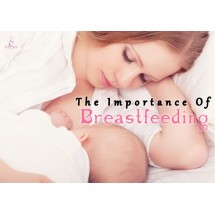 Medical reasons aside, most mothers are able to produce milk for nursing their newborn child. As breastfeeding intake cannot be specifically measured, at one time or another a common worry is whether enough milk is produced fast enough to feed the child adequately.
Medical reasons aside, most mothers are able to produce milk for nursing their newborn child. As breastfeeding intake cannot be specifically measured, at one time or another a common worry is whether enough milk is produced fast enough to feed the child adequately.
Firstly, it is important to determine whether the milk supply is low or if it is due to personal perceptions i.e. expecting baby not to feel hungry for a fixed duration after a feed or a fed baby to sleep through the night. If the baby feeds by direct latch and is allowed to feed as long as he/she wants this is not a problem as the baby will feed till satisfied. The  suckling action generates hormones which induces the let-down reflex.
suckling action generates hormones which induces the let-down reflex.
Generally if a baby presents the below signs, probably enough milk is received.
- Frequent wetting of nappies and bowel movements (frequency depends on age)
- Baby is alert and contented and does not feed all the time. A newborn needs about 8-12 or more feeds per day. However, it is normal to have phases of higher frequency of nursing, such as during growth spurts. Some babies may wake frequently for night feeds which are normal as well.
- Weight, height and head circumference growth – Do not be alarmed if baby loses weight in the first few days of life. This is due to meconium and water loss. According to Successful Breastfeeding by Sister Kang (a lactation consultant from Mt Alvernia), babies should regain birth weight by week 2, and gain 150 to 200g per week, double in birth weight by 4 to 6 months and be at three times birth weight by year 1.
But what if your milk supply is really very low? Here are some ways to improve your milk production.
1. Relax and enjoy nursing times
The most common milk production inhibitors are stress and illness. Settle with baby and nurse your child away from distractions ie. phone or noise. This will help with milk let-down.
2. Breastfeed more frequently with baby correctly latched
Offer a feed every 2-3 hours in the day for a few days or more times in a day. Offer both breasts. Do not use level of engorgement as an indicator of whether you have milk to feed. There is always milk to feed.
3. Let your baby decide how long to feed
Different babies suck differently and duration is not a good gauge of how long a feed should be. Babies need to suckle sufficiently to receive the calorie rich hindmilk.
4. If your baby does not settle after a feed, wait 20 to 30 minutes
After feed provide a brief ‘top-up’ feed. This may help to satisfy the baby.
5. Offering the breast to soothe the baby
Offer your beast to your baby to comfort him rather than providing the pacifier. As it can help to boost the milk build-up.
6. Scheduling too rigidly or being separated for long durations may hinder the milk supply
Milk supply may dip when mothers return to work. Express milk diligently when sick or away to maintain supply. Avoid supplementation, glucose or water for fully breastfed babies unless medically advised.
7. Food that promotes lactation
While there is no miracle food, having sufficient fluid intake first and foremost is important. Some women recommend consuming higher-protein foods, such as fish and green papaya soup.
8. Remedies that helps to promote lactation
Note that these are not scientifically established but some mothers find them helpful in facilitating milk supply. Fenugreek, blessed thistle, alfalfa, spirulina, goat’s rue, raspberry leaf, fennel, brewer’s yeast etc are some herbal remedies that have been used to promote milk supply. Some may exist in different forms e.g. Alfafa exists as dried herb or powder.
Formulations also exist such as lactation teas; one example is Sacred Nursing Tea from Origins Jamu Massage which is USDA organic certified. When taking remedies, do follow instructions accordingly and take at your own discretion.
Ultimately, demand and supply is the principle to go in producing milk. Other ways may facilitate but not be a substitute. At any time, if you suspect an underlying medical condition or require medication, it is important to seek professional medical advice. For massaging and latching issues, a session with a lactation consultant may help to facilitate the breastfeeding process.
Breastfeeding is not easy but it does get easier over time. Plus the many tangible and intangible benefits, makes it worthwhile.
With sufficient nutrition, eating the right diet, breastfeeding support and perseverance, it can be done!
By Som Yew Ya
References: Australian Breastfeeding Association and Successful Breastfeeding guide
This article is part of Breastfeeding with Love campaign, initiated by The New Age Parents and New Age Pregnancy.
Join the Breastfeeding with Love Facebook Group to find out more and be part of our breastfeeding online community!

|
Click on the logos to find out more about our supporting partners.






